Learning Outcomes
After this course, participants will be able to:
- Discuss the Roger for Toddlers portfolio and its benefits to children with hearing loss.
- Describe the audiological features of Roger.
- Discuss the best hearing solutions for children and explain how Roger works with other products.
Introduction
For 45 years, Phonak has been committed to pediatrics. We've been passionate about supporting you and the patients that you serve. We do this, not only with our hearing solutions and counseling tools, but also in four other ways:
- Fostering professional development. We do this via our links, evidence and research that we post on the internet and share on social media and in print form. We also do this by offering courses such as this one.
- Working closely with International Pediatric Advisory Board, which give us guidance in all the things that we do.
- Conducting internal and external research studies through the Phonak Audiology Research Center (PARC). At any given time, we are conducting an extensive amount of research on not only our products, as well as other products.
- Hosting our global pediatric conferences, the most recent of which was in October of 2017 (the unilateral hearing loss conference).
All hearing aids and FM are not created equal. At Phonak, we want to give every child the opportunity to hear and understand in every situation. So they can develop speech, communicate effectively, play, laugh, and be confident in everything that they aspire to be or do. As hearing healthcare professionals, we all want to bring our talents and education to the table and to allow children the ability to be confident. That's why we do what we do.
Challenges: Access to and Acquisition of Speech and Language
The period from birth to age three is the most dynamic and ever-changing period in the life of a human. Within the course of three years, a child progresses from a state of helpless infancy to being a chattering toddler. During this time, every single word that is heard by the child is vital to their development.
In order to be ready for school, a child needs to hear approximately 45 million words by the age of four (Hart & Risley, 1995). In addition, they have to have 20,000 hours of listening in infancy and early childhood as a basis for reading (Dehaene, 2009). Phonak recognizes that a child is not a small adult. They need a tailored pediatric solution that's going to grow with them, as their listening environment changes. We know that children listen and learn differently than adults. They must have a significantly higher signal-to-noise ratio and reduced reverberation times. Additionally, once a child is outside of their hearing aid or cochlear implant "bubble", they're simply not hearing everything. They must have access to quality language input. Everything in a child's environment is new, and in order to be ready for school, a young child needs to hear those 45 million words and have those 20,000 hours of listening.
The Listening Brain
When we use our senses, such as sight, smell and hearing, it is truly the brain that is seeing, smelling and hearing. With regard to sight, the eyes are not what we see with. The eyes are simply a portal to the vision centers of the brain. Similarly, our nose is a conduit for smells to reach our brain and trigger memories. Likewise, we don't truly hear with our ears: we hear with the brain.
Our ears can be thought of as doorways to auditory brain centers. As such, hearing loss can be thought of as a doorway problem, and can be described as an obstruction that prevents the auditory information from reaching the brain (Flexer, 2018). At Phonak, we take this concept to heart when we design everything that we make. The ear is simply the structure that captures the sound from the environment and directs it to the brain. It is the brain that processes and gives meaning to any auditory information. To reiterate, we can think of the ears as a doorway to the auditory brain centers, where hearing truly occurs, and a hearing loss as a doorway problem.
Since we hear with the brain, and not our ears, the brain can only learn to understand information that successfully reaches it. The quality and quantity of speech and language sounds matters significantly to a child. Children need to have that language-rich environment, as well as appropriate amplification and appropriate hearing solutions, in order to develop speech and language. They need to have access to those 45 million words and 20,000 hours of listening. Using modern hearing technology systems, we are able to break through that doorway problem.
Research
Over the last few years, there has been a large, ongoing study, the Outcomes of Children with Hearing Loss study (OCHL). This research has become a guiding light for Phonak Pediatrics. The OCHL is a multi-site, longitudinal study following 317 children between the ages of five months to 17 years. All of the children have mild to severe hearing loss, and either wear hearing aids or cochlear implants. The project was funded by the National Institute on Deafness and Other Communication Disorders (NIDCD), and it is the collaborative effort of three pediatric audiology powerhouses: the University of Iowa, Boys Town National Research Hospital, and the University of North Carolina at Chapel Hill. Multiple publications have resulted from the OCHL, all of which have provided incredibly useful and clinically relevant information about children with hearing loss (McCreery, Walker, Spratford, Bentler, Holte, Roush & Moeller, 2015).
The OCHL study established three key predictors associated with better speech and language development outcomes for children with hearing loss. These three predictors, which essentially guard against language delay, are:
- Well fit hearing aids: As audiologists, it is our job to provide our clients with a well-fit hearing aid. The best fit hearing aids protect against language delay. Greater aided audibility is associated with stronger language and auditory brain development.
- Consistent hearing aid use: Children who wear hearing aids consistently (a minimum of 10-12 hours per day) are more likely to have age-appropriate language skills by the time they enter elementary school.
- Quality language input: Exposure to high quality language input in the home is associated with better language outcomes. Children with hearing loss should be provided a language-rich environment that is complex enough to promote linguistic development.
In addition to well-fit hearing aids and consistent hearing aid use, a Roger system can help a child receive access to the quality language input.
The Solution: Roger
Research has shown that 40% of speech in a child's typical day comes from a distance of over six feet and/or with overlapping noise (Mulla and McCracken, 2014). A child who wears hearing aids or has cochlear implants hears sounds within a "bubble" of a five- or six-foot circumference. Anything outside of that bubble is not being heard clearly, and probably isn't going to contribute to the child's language access. If 40% of what a child hears in a typical day comes from a distance of over six feet, or with overlapping noise, this presents a significant challenge of understanding.
We know that real and meaningful education occurs when children are truly engaged. Children can only be truly engaged with their teachers, parents, or siblings, if they're wearing appropriate technology. Hearing challenges for children with hearing loss include classroom environments, home life, and the outdoors, among many others. In these complex listening situations, it's extremely challenging for a child to hear, even with the best fit amplification. They are still going to struggle.
In the past, FM systems have been used to bring a teacher's or parent's voice directly to the child's hearing instruments to help boost their speech understanding. Phonak has led the FM field for many years. Now, we are leading the field with Roger, named after the aviation term meaning "message received and understood."
Roger is a digital, wireless, remote microphone system (DM) consisting of microphones and receivers. Roger provides speech and language access in noisy situations and over distance. It provides speech and language access in noisy situations when hearing aids and CIs require that boost, to ensure that the user is getting what they need.
Roger Digital Technology
Roger is a 2.4 GHz wireless technology that improves speech understanding. The remote microphone signal measures the environmental noise in real time, and it adjusts the receivers to provide the best signal-to-noise ratio. The microphone is constantly scanning the environment, judging loudness levels and background noise. Then, Roger adjusts what is delivered to the receivers to ensure the best signal-to-noise ratio. This adaptive behavior capability is unique to Roger. It also uses beamformers, which are constantly sampling the environmental noise and adjusting accordingly, so that the child only hears the best SNR. Roger is fully compatible with hearing aids, bone anchored devices, and cochlear implant systems. Phonak has made a universal receiver, as well as integrated receivers into their hearing aids. We even have one you can wear around your neck.
Let's talk a little bit more about the digital wireless characteristics of Roger. It is a 2.4 GHz, globally license free frequency. Audio signals are constantly sampled, and then they are digitized. They are then put into very short digital bursts of codes, or packets. These packets are broadcast several times, each at different channels between 2.4 and 2.4835 GHz. It's a very narrow channel. The audio delay is less than 25 milliseconds. Typical, historical FM systems have a much larger frequency range. One of the problems with that is channel interaction. If you had multiple students in a classroom with different receivers, every one of them had to be programmed to a specific frequency, which didn't always work. If a child were to go to the next classroom, he or she could still hear the teacher through the walls, because the channel didn't change from room to room. With Roger, you don't have to worry about any of that.
Frequency hopping is what Roger does to ensure that the clearest digital signal goes from the microphone to the receivers. It's adaptive and it's automatic. As the audiologist, there's nothing that you need to do, except pair the microphone and the receivers. The microphone will automatically avoid occupied channels. There will be no signal crossover. They will avoid complicated channel schematics for multi-talker networks. In addition, privacy is guaranteed.
Roger Microphone Portfolio
Here we have the Roger microphone portfolio (Figure 1). On the far left, we have the Roger touchscreen mic. This is the primary microphone used in a school setting. That does not mean, however, that it cannot be used at home. It is the "Cadillac" of our microphones, with multiple scrolling pages, many functions, and three microphones. The Roger Pen is very popular with tweens and teens. It also has what we call an accelerometer; it can be laid on the table used in a multi-talker mode. On the far right is the very small Clip-on Mic. This is used a lot in home environments, and not as much in the classroom.
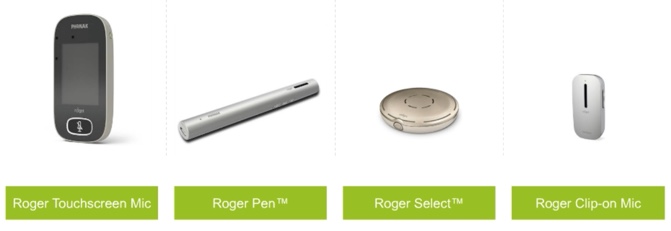
Figure 1. Roger microphone portfolio.
The third one from the left is the Roger Select, which has not begun shipping yet. The Roger Select is about the size of an Oreo cookie. It is unique in that it has three microphones and six beamformers. With the Roger Select, you are able to select to whom you want to listen. There are six buttons, or areas that you can press on the top of the Roger Select to point it at whomever you want to hear the most. Alternatively, you could tap the middle button and it will go into an omni mode, where it will pick up everyone around you. It can also be worn on the lapel, or with a magnetic clip on the shirt. Because there are so many microphones, it doesn't matter if it slips or moves, or if the speaker's head turns. The beamformers are going to follow the speaker's voice, whether that be a teacher or a parent. Technically speaking, the Roger Touchscreen Mic is classified as "Roger for Education", and the other three are considered "Roger for Home". However, there can be a lot of crossover between use in those settings.
These are the Roger receivers (Figure 2). The 18, the 19, the Roger X and the Roger MyLink are all universal. Roger 21 is for MED-EL; Roger 20 is for Advanced Bionics; and Roger 17 is for Cochlear.
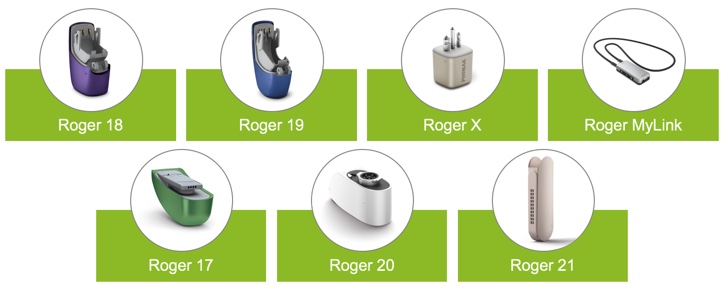
Figure 2. Roger receivers.
A complete Roger system consists of three things to make a remote microphone system: the hearing instrument, the Roger receiver, and the Roger microphone (Figure 3). Together, those three components make up a remote microphone system.
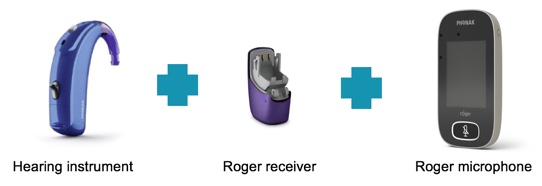
Figure 3. Components of a complete Roger system.
Automatic activation of Roger is one of the features that came out with the introduction of Sky V. It's what we call RogerReady. For those of you who don't know, it means that the device is ready for Roger as a default setting, with no extra programming. The newest hearing aid from us, Sky B, also offers RogerReady, which makes it simple for clinicians to add a Roger system to any Sky B hearing aid with direct audio input, without any additional programming. It also allows children to access the best of both worlds, with AutoSense Sky OS and the Roger and directional settings. It automatically switches into the Roger program, which occurs in less than 400 milliseconds, and it switches out of the Roger program after approximately 50 seconds of no transmission from the microphone. This makes it easy for the audiologist, as well as for the child. The RogerReady is now enabled by default for all Junior mode fittings in Phonak Target. Again, the switch to Roger occurs within less than 400 milliseconds of the speaker talking, ensuring children don't miss the beginning of any sentences. Plus, no one has to remember to turn it on (Standaert & Levy, 2016).
MultiBeam Technology
MultiBeam Technology is included in the Roger Select. It has three microphones, six beamformers, and it is in a constant state of sampling the environment to detect and deliver the signal with the most clarity. It automatically selects the beam with the best and clearest SNR, and delivers that signal to the listener. Research has shown that when using the beamformers, understanding improves by more than 60% in group conversations (Thibodeau, 2018).
The winning Roger strategy is a four-step process:
- We bring the microphone to the source.
- We optimize the signal-to-noise ratio at the source, with the beamformer.
- We adaptively mix the wireless microphone signal and the ear-level microphone, increasing the gain of the Roger receiver in higher ambient noise levels.
- We reduce the gain when no voice is present.
Roger: Benefits for Toddlers
Simply put, use of a Roger system is going to provide access to more: more spoken language, more speech from a distance, and more understanding of speech in noise. Adding that Roger system ensures that the child has access to not only more, but also better speech and language, which will increase the chance for typical development in those areas (Benitez-Barrera, Angley & Tharpe, 2018).
Incidental language learning has been shown to be a vital part of a child's vocabulary and language development. Research suggests that approximately 80 to 90% of what a child learns in their language development is done so incidentally (Gillis & Schaerlaekens, 2000). In other words, talking face-to-face with a child is important; however, conversations that child hears around him (e.g., between mom and dad, between dad and a sibling, between his friends) are critical in the development of speech and language skills. We know that children with hearing loss are going to miss out on incidental language learning. Outside of that five- or six-foot hearing aid bubble, a child is simply not getting what they need. Many conversations that they can hear incidentally are going to occur outside of that bubble. Roger promotes this incidental language learning, because it allows the child to hear not only more, but also more often.
Roger helps children to hear in a variety of situations: at home, in a stroller, in the car, at the park. These are all challenging listening environments. In all of these circumstances, Roger has been used successfully to facilitate communication with hearing impaired children when they have limited or no visual cues, or when they're at a distance of more than five or six feet.
Evidence
To date, there have not been many studies conducted on remote microphone use in homes. But, from the handful that have been done (mostly by the same individuals), caregivers have reported that they feel as if the child has:
- Improved access to speech, incidental learning and overhearing (Flynn, Flynn & Gregory, 2005; Mulla & McCracken, 2013)
- Improved listening skills (Mulla & McCracken, 2014)
- Increased imitation of words and sentences, enhanced clarity of speech, and general well-being of the child (Mulla & McCracken, 2013)
- Improved attention, receptive language, and reduced listening effort and fatigue (Moellner, Donaghy, Beauchaine, Lewis & Stelmachowicz, 1996)
Again, these were all situations where a remote microphone was used at home, although not necessarily on preschoolers.
Most recently, February of 2018, a Vanderbilt study was released by Dr. Benítez-Barrera. The subjects were 10 children with hearing loss and their families. There were four girls and six boys, all of them between two and six years of age. The hearing loss ranged from mild to profound, and included a mix of hearing aids, cochlear implants, and one bone anchored device.
This study occurred over a series of several weekends. On one weekend, the family did not wear a Roger system, and the child wore only his or her hearing aid or cochlear implant. On another weekend, for comparison, the parent wore the transmitter, or the caregiver wore the transmitter, and the child wore the Roger receiver. In addition, all of the speech and language surrounding the child was recorded with a LENA system, which is also worn around the neck. This is a way for us to compare speech in speech out over one weekend versus the next.
They found that consistent use of the Roger at home provided the child access to 5,300 more words per day, which is approximately 11 more words per minute than when the child was wearing only a hearing aid or cochlear implant. Adding Roger, and recording speech from and to that child, with the Roger and without the Roger, the child was able to have access to 5,300 more words in a typical 8-hour day. Even better, they found that 80% of parents reported that their child had greater responsiveness when wearing the Roger unit. Furthermore, 35% of them reported less frustration from their child (Benitez-Barrera, Angley & Tharpe, 2017).
In summary, by the age of four, a child needs 45 million words and 20,000 hours of listening to properly form the the pathway to language. This breaks down to about 11 million words per year, 31,000 words per day, and 51 words per minute. The average English speaker says 150 words per minute; a child needs to hear 51 words per minute. To put it into perspective, the children's book "Goodnight Moon" has 131 words. Also, there are approximately one million words in the entire seven-book Harry Potter series. By the time a child is age four, they would have had to hear the seven-book series 45 times in order to receive 45 million words.
Overall Benefits
Roger is both simple and reliable. It is simple in the way that it transmits automatically and adaptively, constantly searching the environment. What's even more simple is that there are barely any buttons on the Roger Pen, or the Clip-on or the Select. There are more buttons on the touch-screen, but it's still not complicated. With one simple push of a button, receivers are easily connected to the microphones (Figure 4).
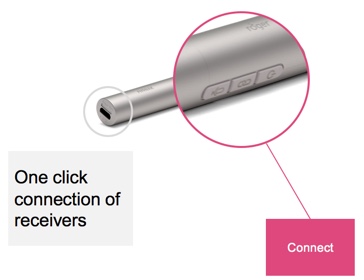
Figure 4. One-click connection of microphones to receivers.
Roger is also water-resistant and dust-resistant. I'm often asked when Phonak is going to be coming out with a waterproof hearing aid. Honestly, with electronic devices, there is no such thing as waterproof; only water-resistant. That being said, Phonak has the highest rating on the market for water resistance, which is IP68. This is true for both Roger and for Phonak hearing aids.
For hearing care professionals, Roger is extremely easy to demonstrate and to show your families how to use it. It's easy to show them the benefits with a demo system, and it is simple to pair. Roger is an extremely reliable unit.
Overall, the benefits of Roger for young children can include the following:
- More speech and language access
- Improved speech understanding
- Easy, reliable and safe
Roger offers evidence-based research which supports better speech and language access and outcomes, and understanding, when used in conjunction with appropriately fit amplification. Improved listening skills lead to improved language behavior and social skills.
BabyBeats
Next, we are going to discuss an additional counseling tool that can be used in conjunction with Roger. It's called BabyBeats. It is relatively new. It is an app for Android or iPhone. It is an early intervention resource, and it establishes pre-verbal skills through interactive, natural musical engagement, which helps to develop the listening brain.
There has been a lot of research about how music can enhance language learning. It has been shown that if a baby is exposed to music, that exposure will strengthen neural pathways and will prime that child for language learning. There is also growing evidence that music assists with early listening and language development, and emotional well-being of children. All of this research is the basis for BabyBeats. In addition, we have designed a way for BabyBeats to be used in conjunction with the Roger system (either the touch-screen mic or the Roger Pen) and the child's receivers, to ensure that the child has access to everything that this application has to offer.
Why should we use BabyBeats? BabyBeats is easy to use. It offers simple and fun activities for parents and babies or toddlers to do together to improve the child's language and listening. When BabyBeats was used in conjunction with Roger, parents reported seeing improvements in their infant's or toddler's early listening and communications skills. In addition, they witnessed improved interest in sounds, attention, reaction and copying at other times of the day, when they were not using BabyBeats. Parents also felt more confident interacting with their child, increasingly using their voice during play activities. Using BabyBeats, parents felt more relaxed when playing with their infants. They reported that their children displayed more nonverbal communication, and were engaged in more face-to-face interaction. All of the parents stated that they greatly enjoyed using all four musical trials (parents surveyed at the Elizabeth Foundation, UK). If you can download the BabyBeats app, I think that you will find that it is a great resource that truly helps prepare children pre-lingually to learn to listen and talk. If you are interested, I can provide you with the fact sheet for BabyBeats and Roger, so that you can share those with your families.
This is what the app looks like (Figure 5). There are four activities to choose from: movement and music, explore instruments, explore animals and explore transportation. Along the bottom of the screen, you can navigate the app using the home menu, the guide screen, the music screen and pictures. The last option on the bottom right provides the user all of the research supporting why we should use BabyBeats.
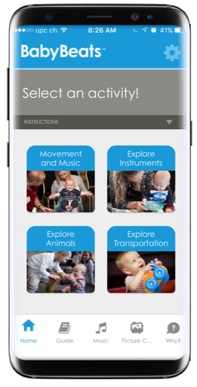
Figure 5. BabyBeats app.
Summary and Conclusion
I want to share a cute story with you. One little four-year-old girl that I know lives on a farm. She is hearing impaired. Her parents drive a very large and very loud diesel truck. She has had a lot of trouble hearing in the back seat when she is in the truck with her family. She obtained a Roger system a few months ago, and now her parents use the microphones in the front seat, she uses the receivers in the back seat. She can hear over the sound of the loud diesel truck and understand what her parents are saying to her. The reason I love this story is because she's four years old, and she has a huge vocabulary. Her concern was that the truck was too noisy and she couldn't hear her parents. Now she's just so excited to be wearing her Roger system.
We are in this together. Phonak is built on 45 years of commitment to the most precious years and the most precious ears. We share a commitment to let every child live their life without limits. Together, we support the best possible outcomes for children with hearing loss. Using Phonak hearing aids, in conjunction with a Roger receiver and a Roger microphone, along with BabyBeats, will ensure that those tiny ears and those big brains are primed for language learning.
To summarize, we have strong research to support that using Roger on preschoolers has wonderful benefits. They hear 11 more words per minute, and 5,300 more words per day when they are using a Roger system, compared to when they are using only their hearing aids or their cochlear implants. A child needs to have a language-rich environment. A child needs to have well fit hearing aids. A child needs to consistently wear their devices. Taken together with what we know about what Roger can do, we have a pretty clear picture of what we need to do for these children in order for them to have the best access, and the most access to speech and language in their environment. As we like to say at Phonak, when a child can hear more words, life is on.
References
Benitez-Barrera, C. R., AngleyG. P., & Tharpe, A.M. (2018). Remote microphone system use at home: impact on caregiver talk. J Speech Lang Hear Res, 1-11.
Dehaene, S. (2009). Reading in the brain: the science and evolution of a human invention. New York, NY: Viking.
Flexer, C. (2018). The ears are doorways to the brain. Phonak Insight. Retrieved from www.phonakpro.com/evidence, accessed February 19th, 2018
Gillis, S., & Schaerlaekens, A. (Eds.). (2000). Child language acquisition: A handbook for Dutch. Groningen:MartinusNijhoff.
Hart, B., & Risley, T. R. (1995). Meaningful differences in the everyday experience of young American children. Paul H Brookes Publishing.
McCreery, R. W., Walker, E. A., Spratford, M., Bentler, R., Holte, L., Roush, P., & Moeller, M. P. (2015). Longitudinal predictors of aided speech audibility in infants and children.
Ear and Hearing, 36 Suppl 1, 24–37.
Moeller, M. P., Donaghy, K. F., Beauchaine, K. L., Lewis, D. E., & Stelmachowicz, P. G. (1996). Longitudinal study of FM system use in nonacademic settings: Effects on language development. Ear and hearing, 17(1), 28-41.
Mulla, I., & McCracken, W. (2013). The use of FM technology for pre-school children with hearing loss. Phonak Pro.
Mulla, I., & McCracken, W. (2014). Frequency modulation for preschoolers with hearing loss. In Seminars in Hearing, 35, (3), 206-216. Thieme Medical Publishers.
Standaert, L. & Levy, C. RogerReady. Automating the roger experience. Field Study News (April, 2016)
Citation
Cunningham, R. (2018, June). Roger for young children. AudiologyOnline, Article 23116. Retrieved from www.audiologyonline.com


